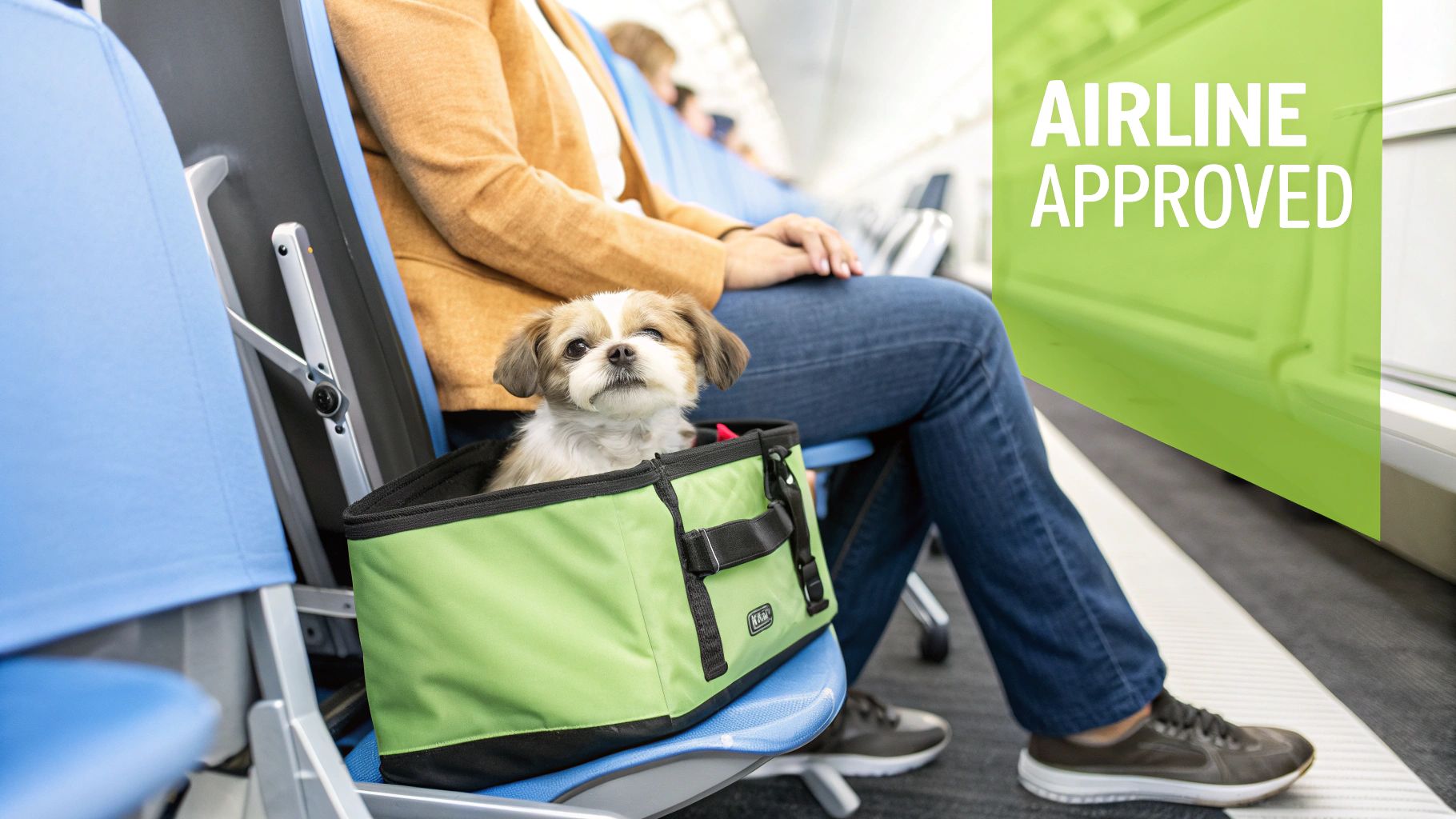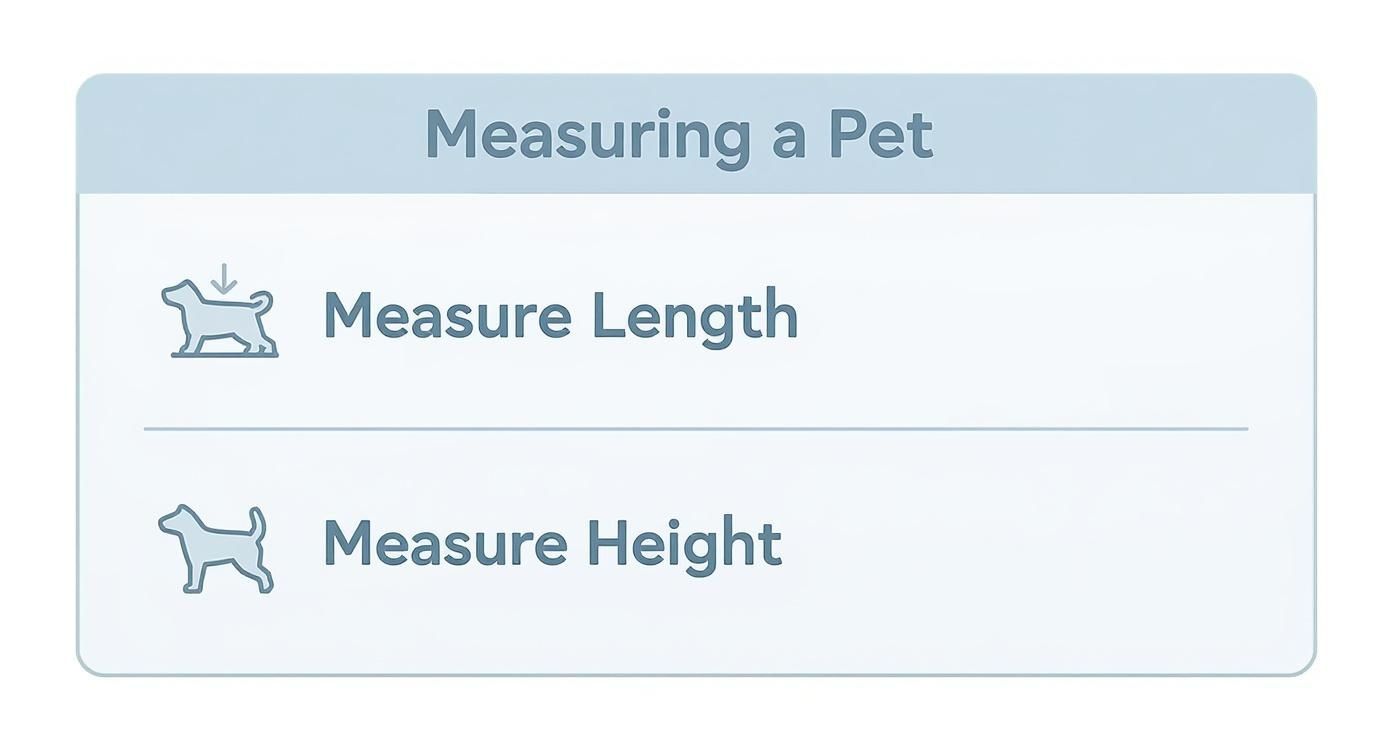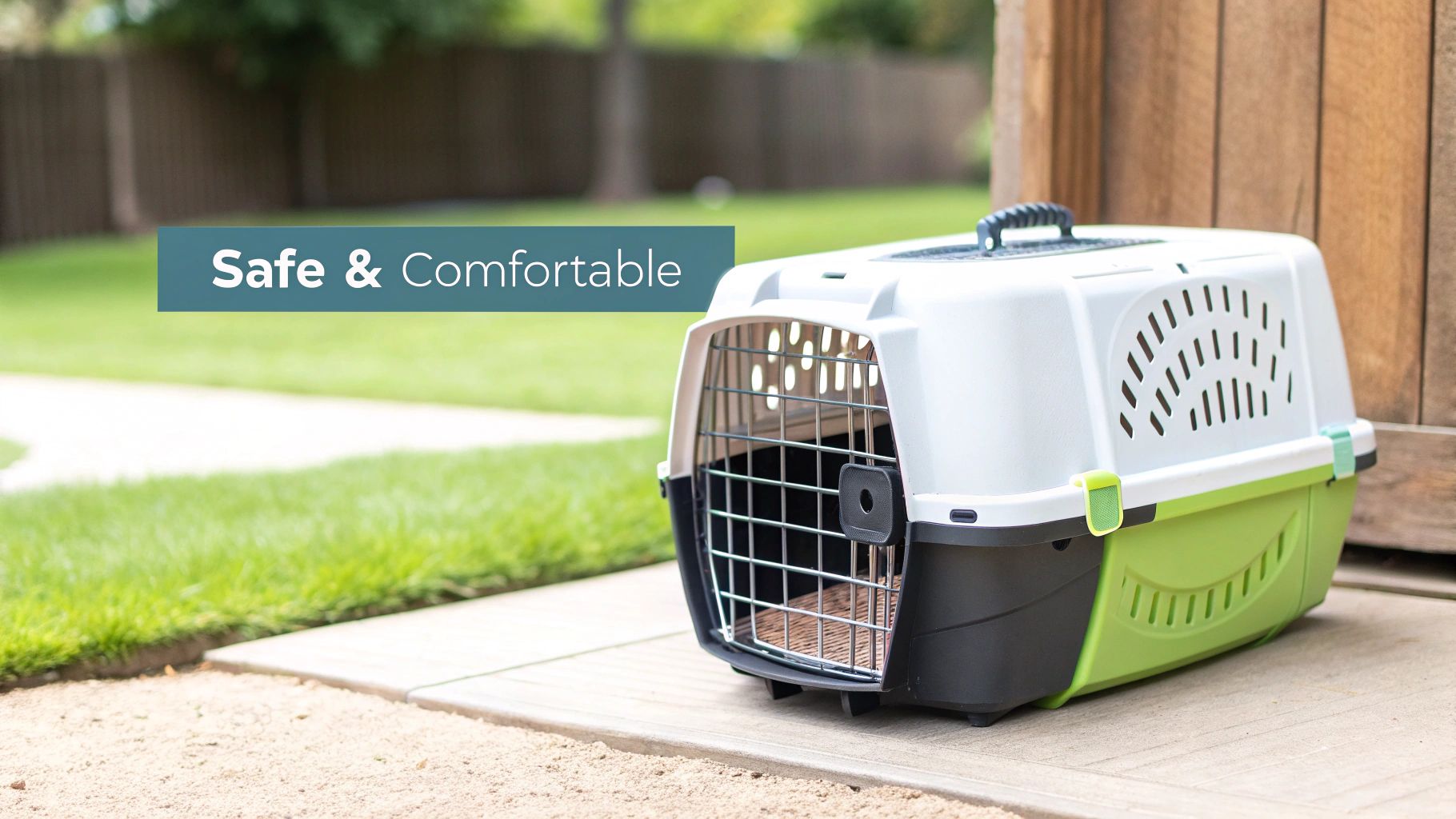Airline Pet Carrier Size Requirements Made Simple

Traveling with your furry best friend doesn't have to be a roll of the dice. Mastering the airline pet carrier size requirements is your first and most critical step for a smooth journey.
Here's the bottom line: your pet's carrier must be small enough to slide and fit securely under the seat in front of you, just like a personal item. This rule isn't about saving space; it's a non-negotiable safety measure for your pet during the flight.
Cracking the Code on Airline Approved Pet Carriers

Don't let the term "airline approved" confuse you. It’s not an official certification. Instead, think of it as a practical checklist of safety and comfort features every airline requires. Their primary goal is simple: ensure the carrier fits safely in the confined space of a plane cabin.
With over 4 million animals flying globally each year, these guidelines are essential for safe and orderly travel. Airlines standardize their rules to ensure the safety of every passenger and pet on board.
Core Features of an Approved Carrier
Getting the dimensions right is only half the battle. To be flight-ready, your carrier must have several other crucial features designed for your pet's security and comfort. A compliant carrier is the complete package—size is just the starting point.
To get a green light at the gate, your carrier must have:
- Proper Ventilation: Look for mesh windows on at least three sides. This is non-negotiable for airflow and prevents your pet from overheating.
- A Leak-Proof Bottom: A waterproof base is essential to contain any accidents, keeping your pet and the cabin clean.
- Secure Zippers: Choose a carrier with locking zippers or durable closures to prevent a clever pet from escaping mid-flight.
- Sufficient Space: Your pet must be able to stand up, turn around, and lie down comfortably. Do not force them into a carrier that is too small.
Actionable Tip: The most common reason pets are denied boarding is a non-compliant carrier. Verify your carrier meets these four criteria before you get to the airport to avoid last-minute stress and disappointment.
For a deeper look at selecting the right carrier for your cat, our guide on airline-approved cat carriers provides more targeted advice for a smooth journey.
How to Measure Your Pet for the Perfect Carrier Fit
Accurately measuring your pet is the single most important action you can take to ensure a smooth travel day. An incorrect measurement can lead to a carrier that’s too small, making the trip miserable for your pet and risking being turned away at the gate.
The good news is it only takes a few minutes. All you need is a soft measuring tape. For the most accurate results, have your pet stand straight on all fours. If they’re wiggly, ask a friend to help and use treats to make the process easier.
Step 1: Measure Your Pet's Length
Start with length. Place the end of the tape measure at the tip of your pet's nose and extend it along their spine to the base of their tail (where the tail connects to the body). Do not include the tail in this measurement. This number determines the minimum length for your carrier.
Step 2: Measure Your Pet's Height
Next, measure height. While your pet is standing, measure from the floor to the top of their head or the tips of their ears—whichever is highest. This measurement is critical, as airlines require your pet to be able to stand up inside the carrier without crouching.
Actionable Tip: Once you have a carrier, perform this simple test: Can your pet stand up, turn around, and lie down naturally inside it? If they can’t perform these basic movements, the carrier is too small, and you must get a larger one to be compliant.
The International Air Transport Association (IATA) offers professional guidelines, advising that the carrier should be as long as your pet's body plus half their leg length. They also recommend the carrier's height match your pet's full standing height for adequate headroom.
Soft-Sided vs. Hard-Sided Carriers
Now, choose your carrier type. For in-cabin travel, soft-sided carriers are almost always the best practical choice. Their flexible structure allows them to compress slightly to fit under various airline seats, which is a major advantage since under-seat dimensions can vary.
Hard-sided carriers offer robust protection but have no flexibility. If a hard carrier is even a fraction of an inch too tall, it simply won't fit. A quality soft-sided carrier gives you the ideal blend of comfort, safety, and adaptability for in-cabin flights.
A Look at In-Cabin Pet Policies for Major US Airlines
Navigating airline pet carrier size requirements can feel like hitting a moving target. Each airline has its own specific rules, and what's acceptable on one may not be on another. The most important action you can take is to check the airline's policy before you book.
Airlines publish maximum carrier dimensions, but these are typically based on the smallest under-seat space in their entire fleet. The actual space on your specific aircraft might differ. This variability is why a flexible, soft-sided carrier is your most reliable option for in-cabin travel.
Before selecting a carrier, you must measure your pet. Use our guide on how to measure your pet as your first step to ensure you choose a carrier that is both compliant and comfortable.

This graphic highlights the two most critical measurements for airlines: length and height. Getting these right is your first step toward a stress-free travel day for both you and your pet.
Major US Airline In-Cabin Pet Carrier Requirements
While policies can change, understanding the general requirements of major airlines gives you a strong starting point. Your golden rule should always be: confirm the most current rules directly on the airline’s website before purchasing your ticket.
Here is a quick-glance table comparing the in-cabin pet carrier rules for several major US airlines to help you plan.
| Airline | Max Carrier Dimensions (L x W x H) | Max Pet Weight | Carrier Type | Key Notes |
|---|---|---|---|---|
| Delta Air Lines | Varies by aircraft | No specific weight limit, but must fit | Soft or hard-sided | You must call to confirm dimensions for your specific flight. |
| United Airlines | 18" x 11" x 11" | No specific weight limit, but must fit | Soft or hard-sided | Soft-sided carriers are strongly recommended. |
| American Airlines | 18" x 11" x 11" (soft) | 20 lbs (combined pet + carrier) | Soft or hard-sided | Hard-sided carriers have smaller dimensions (19" x 13" x 9"). |
| Southwest Airlines | 18.5" x 13.5" x 9.5" | No specific weight limit, but must fit | Soft or hard-sided | Offers some of the largest dimensions for soft carriers. |
| Alaska Airlines | 17" x 11" x 9.5" (soft) | 20 lbs (combined pet + carrier) | Soft or hard-sided | Hard-sided carrier dimensions are smaller (17" x 11" x 7.5"). |
Quick Note: Use these dimensions as a guideline, but always verify with the airline. Weight limits typically include both your pet and the carrier.
As the table shows, there is no universal standard. Always check the rules for your specific airline.
Key Policy Differences to Watch For
The fine print in each airline's policy is what often causes problems at the airport. Pay attention to these details.
For instance, Southwest Airlines only permits pets to travel in the cabin and does not offer a cargo option. Many airlines also limit the total number of pets per flight, making it a first-come, first-served system. This means you must book your pet’s spot as early as possible.
Actionable Tip: Booking your ticket does not automatically reserve a spot for your pet. After you book your flight, you must call the airline directly to add your pet to the reservation and pay the fee (typically $95-$125 each way). This crucial step secures their spot and prevents being turned away at check-in.
Navigating Cargo vs. In-Cabin Pet Travel Rules
If your pet is too large to fit under the seat, you'll need to follow a completely different set of rules for cargo travel. This involves different carrier types, safety protocols, and a separate preparation checklist. Understanding these requirements is key to a safe journey for larger pets.
The primary deciding factor is your pet's combined size and weight. While specifics vary, the general cutoff for in-cabin travel is around 14 kg (30 lbs), including the carrier. Beyond that weight, your pet will likely need to fly as cargo in a durable, hard-sided crate that meets strict international standards. You can review these specific IATA container rules at travelreadypets.com.
The Shift to Hard-Sided Cargo Crates
For cargo travel, soft-sided carriers are not allowed. You must use a crate that meets the rigorous standards set by the International Air Transport Association (IATA).
These crates are designed for maximum security and must have:
- A solid, hard-sided shell made from rigid plastic, wood, or metal.
- Secure metal nuts and bolts holding the top and bottom halves together—plastic clips are generally prohibited.
- A single metal door that locks securely to prevent accidental opening.
- Sufficient ventilation on at least three sides to ensure constant fresh airflow.
Actionable Tip: When you purchase a cargo crate, ensure your pet can stand up straight, turn completely around, and lie down comfortably without touching the sides or top. The airline will verify this at check-in.
Critical Safety and Breed Considerations
Beyond the crate, other safety factors are paramount for cargo travel. The cargo hold is pressurized and climate-controlled, but airlines often impose temperature embargoes during extreme weather. This means they will not transport pets if the temperature anywhere on your route—departure, arrival, or layover—is below 45°F or above 85°F.
Additionally, many airlines restrict brachycephalic (short-nosed) breeds like Pugs, French Bulldogs, and Persian cats from flying in cargo due to their increased risk of respiratory issues. Always check your airline’s specific breed restriction list before booking. If you need a durable, compliant option, our IATA-compliant hard carrier is an excellent place to start.
Choosing a Carrier That Ensures Safety and Comfort

Once you've confirmed the airline's size requirements, you can select a carrier that your pet will find safe and comfortable. The right dimensions are the minimum requirement; the best carriers are designed with your pet's well-being and your convenience in mind.
From your pet's perspective, an airport is loud and chaotic. The right carrier functions as a personal safe space, helping them stay calm amidst the stress of travel.
Essential Features for a Stress-Free Journey
Prioritize features that guarantee a secure and comfortable trip. These are the non-negotiable elements that define a high-quality pet carrier.
Here’s your checklist for what to look for:
- Ample Ventilation: Mesh windows on at least three sides are crucial for proper airflow and to prevent overheating. They also allow your pet to see their surroundings, which can reduce anxiety.
- Secure Locking Zippers: An escape-proof design is a must. Look for carriers with sturdy locking zippers or clasps that your pet cannot open.
- Leak-Proof Base: Accidents can happen. A durable, waterproof base is essential for containing spills and keeping your pet and the cabin clean.
Convenience Features That Make a Difference
Beyond the essentials, some features are designed to make your journey through the airport easier. These thoughtful additions can streamline your travel experience.
Actionable Tip: Your comfort is also important. A carrier that is difficult to carry will add to your stress, which your pet can sense. Choose a design that works for both of you.
Look for carriers with padded shoulder straps for easier carrying and multiple entry points (top and side-loading) for convenient access to your pet. External pockets are also extremely useful for storing your pet’s health certificate, a leash, and treats.
Finding the right combination of these features is key. You can explore a variety of TSA-approved pet travel carriers to find the perfect option for your specific travel needs.
Your Pre-Flight Checklist for a Smooth Journey
Meeting airline pet carrier size requirements is a major step, but a truly seamless journey requires preparation well before you head to the airport. A prepared pet is a calm pet. Taking proactive steps can significantly reduce travel-day stress for both of you.
Your goal is to build a positive association with the carrier. Help your pet see it not as a cage, but as their personal, safe den.
Acclimate Your Pet to Their Carrier
Start this process at least two to three weeks before your flight. Leave the carrier open in your living room with a favorite blanket and some toys inside. Let your pet explore it on their own terms.
Periodically, toss treats inside and praise them when they go in. This simple conditioning builds a powerful positive connection, helping them feel secure rather than trapped when it's time to travel.
Actionable Tip: The most effective way to reduce your pet's travel stress is to make them view their carrier as a safe space. This pre-flight training is as critical as meeting the size requirements.
Final Preparations for Travel Day
As your departure date approaches, focus on the details that will ensure travel day goes smoothly.
-
Pack Smart for Comfort: Line the carrier with a familiar blanket or an old t-shirt that smells like home. To save space, pack essentials like food, water, and lightweight collapsible travel bowls for your pet.
-
Time Meals and Potty Breaks: To minimize the chance of accidents, avoid feeding your pet for four to six hours before the flight. Always provide one last potty break just before entering the airport.
-
Gather Essential Documents: Have your pet’s health certificate (most airlines require one issued within 10 days of travel) and vaccination records in an easily accessible pocket. As a backup, save digital copies to your phone.
Frequently Asked Questions
Even with careful planning, questions about the fine print of airline pet carrier size requirements often arise. Here are answers to the most common queries from pet owners.
What If My Soft-Sided Carrier Is Slightly Too Big?
This is a risk, and the airline has the right to deny boarding. While soft-sided carriers offer some flexibility and an agent might allow it if it can be compressed to fit without stressing your pet, this is never guaranteed.
Actionable Tip: The only way to guarantee a stress-free experience is to adhere to the airline's stated dimensions. Don't rely on the leniency of a gate agent.
Sticking to the rules from the start eliminates the risk of last-minute complications that could derail your travel plans.
Can Two Small Pets Share One Carrier?
This depends entirely on the airline. Some, like Alaska Airlines, may permit two very small pets of the same species in one carrier if they have enough room to be comfortable.
However, many others, including United, enforce a strict one-pet-per-carrier policy. You must check your airline’s policy on this before you book to avoid any issues at the check-in counter.
Do Different Rules Apply to Emotional Support Animals?
No, not anymore. Recent changes to regulations mean that most major U.S. airlines no longer recognize emotional support animals (ESAs) as a separate category from pets.
This means ESAs must now follow all standard pet travel rules. They are subject to the same pet fees, and their carrier must meet the airline pet carrier size requirements and fit securely under the seat in front of you.
For a carrier designed to hit all these marks with style and comfort, you can trust Pet Magasin. Check out our collection of TSA-approved carriers and travel with the confidence that you're prepared. Find the perfect ride for your furry co-pilot at https://www.petmagasin.com.





Leave a comment